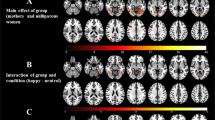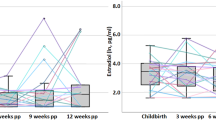Abstract
Objective:
The birth of a preterm infant and Neonatal Intensive Care Unit hospitalization constitute a potentially traumatic experience for mothers. Although behavioral studies investigated the parenting stress in preterm mothers, no study focused on the underlying neural mechanisms. We examined the effect of preterm births in mothers, by comparing brain activation in mothers of preterm and full-term infants.
Study Design:
We used functional magnetic resonance imaging to measure the cerebral response of 10 first-time mothers of preterm infants (gestational age <32 weeks and/or birth weight <1500) and 11 mothers of full-term infants, viewing happy-, neutral- and distress-face images of their own infant, along with a matched unknown infant.
Results:
While viewing own infant’s face preterm mothers showed increased activation in emotional processing area (i.e., inferior frontal gyrus) and social cognition (i.e., supramarginal gyrus) and affiliative behavior (i.e., insula).
Conclusion:
Differential brain activation patterns in mothers appears to be a function of the atypical parenthood transition related to prematurity.
This is a preview of subscription content, access via your institution
Access options
Subscribe to this journal
Receive 12 print issues and online access
$259.00 per year
only $21.58 per issue
Buy this article
- Purchase on Springer Link
- Instant access to full article PDF
Prices may be subject to local taxes which are calculated during checkout


Similar content being viewed by others
References
Hynan MT, Mounts KO, Vanderbilt DL . Screening parents of high-risk infants for emotional distress: rationale and recommendations. J Perinatol 2013; 33 (10): 748–753.
Aagaard H, Hall EOC . Mothers’ experiences of having a preterm infant in the neonatal care unit: a meta-synthesis. J Pediatr Nurs 2008; 23 (3): e26–e36.
Neri E, Agostini F, Salvatori P, Biasini A, Monti F . Mother-preterm infant interactions at 3 months of corrected age: influence of maternal depression, anxiety and neonatal birth weight. Front Psychol 2015; 6: 1234.
Korja R, Latva R, Lehtonen L . The effects of preterm birth on mother-infant interaction and attachment during the infant’s first two years. Acta Obstet Gynecol Scand 2012; 91 (2): 164–173.
Bilgin A, Wolke D . Maternal sensitivity in parenting preterm children: a meta-analysis. Pediatrics 2015; 136 (1): e177–e193.
Bozzette M . A review of research on premature infant-mother interaction. Newborn Infant Nurs Rev 2007; 7 (1): 49–55.
Shandor Miles M, Holditch-Davis D . Compensatory parenting: How mothers describe parenting their 3-year-old, prematurely born children. J Pediatr Nurs 1995; 10 (4): 243–253.
Holditch-Davis D, Schwartz T, Black B, Scher M . Correlates of mother–premature infant interactions. Res Nurs Health 2007; 30 (3): 333–346.
Coppola G, Cassibba R . Mothers’ social behaviours in the NICU during newborns' hospitalisation: an observational approach. J Reprod Infant Psychol 2010; 28 (2): 200–211.
Hurst I . Vigilant watching over. J Perinat Neonatal Nurs 2001; 15 (3): 39–57.
Kynø NM, Ravn IH, Lindemann R, Smeby NA, Torgersen AM, Gundersen T . Parents of preterm-born children; sources of stress and worry and experiences with an early intervention programme—a qualitative study. BMC Nurs 2013; 12 (1): 28.
Howe T-H, Sheu C-F, Wang T-N, Hsu Y-W . Parenting stress in families with very low birth weight preterm infants in early infancy. Res Dev Disabil 2014; 35 (7): 1748–1756.
Silverman ME, Loudon H, Safier M, Protopopescu X, Leiter G, Liu X et al. Neural dysfunction in postpartum depression: an fMRI pilot study. CNS Spectr 2007; 12 (11): 853–862.
Moses-Kolko EL, Perlman SB, Wisner KL, James J, Saul AT, Phillips ML . Abnormally reduced dorsomedial prefrontal cortical activity and effective connectivity with amygdala in response to negative emotional faces in postpartum depression. Am J Psychiatry 2010; 167 (11): 1373–1380.
Atzil S, Hendler T, Feldman R . Specifying the neurobiological basis of human attachment: brain, hormones, and behavior in synchronous and intrusive mothers. Neuropsychopharmacology 2011; 36 (13): 2603–2615.
Barrett J, Wonch KE, Gonzalez A, Ali N, Steiner M, Hall GB et al. Maternal affect and quality of parenting experiences are related to amygdala response to infant faces. Soc Neurosci 2012; 7 (3): 252–268.
Wan MW, Downey D, Strachan H, Elliott R, Williams SR, Abel KM . The neural basis of maternal bonding. PLoS ONE 2014; 9 (3): e88436.
Kim P, Leckman JF, Mayes LC, Feldman R, Wang X, Swain JE . The plasticity of human maternal brain: Longitudinal changes in brain anatomy during the early postpartum period. Behav Neurosci 2010; 124 (5): 695–700.
Strathearn L, Li J, Fonagy P, Montague PR . What’s in a smile? Maternal brain responses to infant facial cues. Pediatrics 2008; 122 (1): 40–51.
Leibenluft E, Gobbini MI, Harrison T, Haxby JV . Mothers’ neural activation in response to pictures of their children and other children. Biol Psychiatry 2004; 56 (4): 225–232.
Lorberbaum JP, Newman JD, Horwitz AR, Dubno JR, Lydiard RB, Hamner MB et al. A potential role for thalamocingulate circuitry in human maternal behavior. Biol Psychiatry 2002; 51 (6): 431–445.
Hollingshead A . Four factor index of social status. Yale J Sociol 1975; 8: 21–52.
Cox JL, Holden JM, Sagovsky R . Detection of postnatal depression: development of the 10-item Edinburgh Postnatal Depression Scale. Br J Psychiatry 1987; 150: 782–786.
Benvenuti P, Ferrara M, Niccolai C, Valoriani V, Cox JL . The Edinburgh Postnatal Depression Scale: validation for an Italian sample. J Affect Disord 1999; 53 (2): 137–141.
Spielberger CD . Assessment of state and trait anxiety: conceptual and methodological issues. South Psychol 1985; 2 (4): 6–16.
Glocker ML, Langleben DD, Ruparel K, Loughead JW, Valdez JN, Griffin MD et al. Baby schema modulates the brain reward system in nulliparous women. Proc Natl Acad Sci USA 2009; 106 (22): 9115–9119.
Luo L, Ma X, Zheng X, Zhao W, Xu L, Becker B et al. Neural systems and hormones mediating attraction to infant and child faces. Front Psychol 2015; 6: 970.
Nakamura K, Kawashima R, Ito K, Sugiura M, Kato T, Nakamura A et al. Activation of the right inferior frontal cortex during assessment of facial emotion. J Neurophysiol 1999; 82 (3): 1610–1614.
Musser ED, Kaiser-Laurent H, Ablow JC . The neural correlates of maternal sensitivity: an fMRI study. Dev Cogn Neurosci 2012; 2 (4): 428–436.
Rizzolatti G, Craighero L . The mirror-neuron system. Annu Rev Neurosci 2004; 27: 169–192.
Kilner JM, Neal A, Weiskopf N, Friston KJ, Frith CD . Evidence of mirror neurons in human inferior frontal gyrus. J Neurosci 2009; 29. (32): 10153–10159.
Carr L, Iacoboni M, Dubeau M-C, Mazziotta JC, Lenzi GL . Neural mechanisms of empathy in humans: a relay from neural systems for imitation to limbic areas. Proc Natl Acad Sci USA 2003; 100 (9): 5497–5502.
Lenzi D, Trentini C, Pantano P, MacAluso E, Iacoboni M, Lenzi GL et al. Neural basis of maternal communication and emotional expression processing during infant preverbal stage. Cereb Cortex 2009; 19 (5): 1124–1133.
Berlucchi G, Aglioti S . The body in the brain: neural bases of corporeal awareness. Trends Neurosci 1997; 20 (12): 560–564.
Adolphs R, Damasio H, Tranel D, Cooper G, Damasio AR . A role for somatosensory cortices in the visual recognition of emotion as revealed by three-dimensional lesion mapping. J Neurosci 2000; 20 (7): 2683–2690.
Silani G, Lamm C, Ruff CC, Singer T . Right supramarginal gyrus is crucial to overcome emotional egocentricity bias in social judgments. J Neurosci 2013; 33 (39): 15466–15476.
Adolphs R . The neurobiology of social cognition. Curr Opin Neurobiol 2001; 11 (2): 231–239.
Riem MME, Bakermans-Kranenburg MJ, Pieper S, Tops M, Boksem MAS, Vermeiren RRJM et al. Oxytocin modulates amygdala, insula, and inferior frontal gyrus responses to infant crying: a randomized controlled trial. Biol Psychiatry 2011; 70 (3): 291–297.
Strathearn L, Fonagy P, Amico J, Montague PR . Adult attachment predicts maternal brain and oxytocin response to infant cues. Neuropsychopharmacology 2009; 34 (13): 2655–2666.
Bartels A, Zeki S . The neural correlates of maternal and romantic love. Neuroimage 2004; 21 (3): 1155–1166.
Ida Gobbini M, Leibenluft E, Santiago N, Haxby JV . Social and emotional attachment in the neural representation of faces. Neuroimage 2004; 22 (4): 1628–1635.
Ranote S, Elliott R, Abel KM, Mitchell R, Deakin JFW, Appleby L . The neural basis of maternal responsiveness to infants: an fMRI study. Neuroreport 2004; 15 (11): 1825–1829.
Noriuchi M, Kikuchi Y, Senoo A . The functional neuroanatomy of maternal love: mother’s response to infant’s attachment behaviors. Biol Psychiatry 2008; 63 (4): 415–423.
Strathearn L, Kim S . Mothers’ amygdala response to positive or negative infant affect is modulated by personal relevance. Front Neurosci 2013; 7: 176.
Barrett J, Fleming AS . Annual Research Review: all mothers are not created equal—neural and psychobiological perspectives on mothering and the importance of individual differences. J Child Psychol Psychiatry 2011; 52 (4): 368–397.
Silverman ME, Loudon H, Liu X, Mauro C, Leiter G, Goldstein MA . The neural processing of negative emotion postpartum: a preliminary study of amygdala function in postpartum depression. Arch Womens Ment Health 2011; 14 (4): 355–359.
Wonch KE, de Medeiros CB, Barrett JA, Dudin A, Cunningham WA, Hall GB et al. Postpartum depression and brain response to infants: differential amygdala response and connectivity. Soc Neurosci 2016; 11: 600–617.
Swain JE, Tasgin E, Mayes LC, Feldman R, Todd Constable R, Leckman JF . Maternal brain response to own baby-cry is affected by cesarean section delivery. J Child Psychol Psychiatry 2008; 49 (10): 1042–1052.
Kim S, Fonagy P, Allen J, Strathearn L . Mothers’ unresolved trauma blunts amygdala response to infant distress. Soc Neurosci 2014; 9 (4): 352–363.
Acknowledgements
Many thanks to Alberto Del Prete, Department of Neonatal Care and Neonatal Intensive Care Unit, Manzoni Hospital, Lecco, Italy and Francesco Morandi, Pediatric Unit, Sacra Famiglia Hospital, Erba, Como, Italy for their help in the recruitment of preterm and full-term mothers. We are very grateful to all the mothers participating in this study. This research was partially supported by the Italian Health Ministry (Ricerca Corrente 2011: Le basi neurobiologiche dell’interazione precoce madre-bambino: studio clinico, neurochimico, neurofisiologico e di neuroimaging funzionale).
Author information
Authors and Affiliations
Corresponding author
Ethics declarations
Competing interests
The authors declare no conflict of interest.
Additional information
AUTHOR CONTRIBUTIONS
The first author wrote the first version of the draft.
Rights and permissions
About this article
Cite this article
Montirosso, R., Arrigoni, F., Casini, E. et al. Greater brain response to emotional expressions of their own children in mothers of preterm infants: an fMRI study. J Perinatol 37, 716–722 (2017). https://doi.org/10.1038/jp.2017.2
Received:
Revised:
Accepted:
Published:
Issue Date:
DOI: https://doi.org/10.1038/jp.2017.2
This article is cited by
-
Brain plasticity in pregnancy and the postpartum period: links to maternal caregiving and mental health
Archives of Women's Mental Health (2019)



